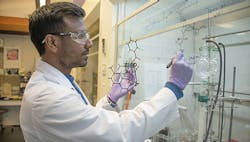Organic Catalyst Boasts Big Benefits
An enzyme-mimicking catalyst opens a new route to important organic molecules such as glycolic acid and amino acids from pyruvate, report researchers in Japan. Moreover, the new catalyst is cheaper, more stable, safer and more environmentally friendly than conventional metal catalysts used in industry, they note, adding that it also displays the high enantioselectivity required by the pharmaceutical industry.
“On top of these advantages, our newly developed organic catalyst system also promotes reactions using pyruvate that aren’t easily achievable using metal catalysts,” says Santanu Mondal, a PhD candidate in the chemistry and chemical bioengineering unit at Okinawa Institute of Science and Technology (OIST) Graduate University, Okinawa, Japan, and lead author of a study recently published in Organic Letters.
“Organic catalysts, in particular, are set to revolutionize the industry and make chemistry more sustainable,” he stresses.
The researchers use an acid and an amine mixture to force the pyruvate to act as an electron donor rather than its usual role as an electron receiver (Figure 1).
Effectively mimicking how enzymes work, the amine binds to the pyruvate to make an intermediate molecule. The organic acid then covers up part of the intermediate molecule while leaving another part that can donate electrons free to react to form a new product.
Currently, the organic catalyst system only works when reacting pyruvate with a specific class of organic molecule called cyclic imines.
So, the researchers now are looking to develop a more-universal catalyst, i.e., one that can speed up reactions between pyruvate and a broad range of organic molecules.
The challenge here is to try to make the electron-donating intermediate stage of pyruvate react with other functional groups such as aldehydes and ketones. However, different catalysts create different intermediates, all with different properties. For example, the enamine intermediate created by the researchers’ new reaction only reacts with cyclic imines. Their hypothesis, currently being investigated, is that creation of other intermediates such as an enolate, if possible, would achieve a broader pyruvate reactivity.
In terms of cost, the researchers note that a palladium catalyst used in similar reactions is 25 times more expensive than their organic acid — which also is made from eco-friendly quinine.
In addition, they believe scale-up of the process for industrial use definitely is possible. However, the researchers caution that the current amine-to-acid-catalyst loading ratio of 1:2 probably would need to be optimized for better results at a larger scale.
